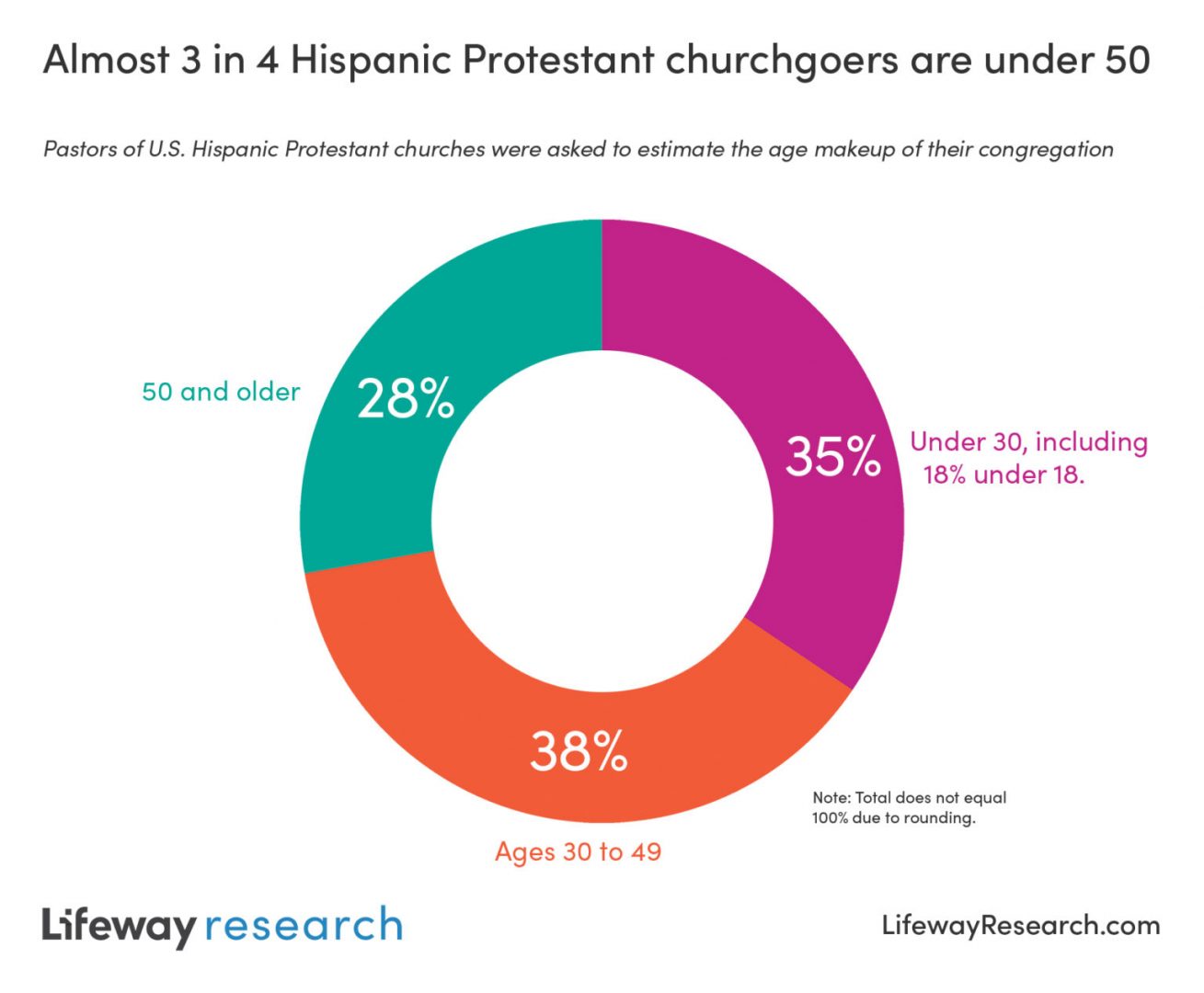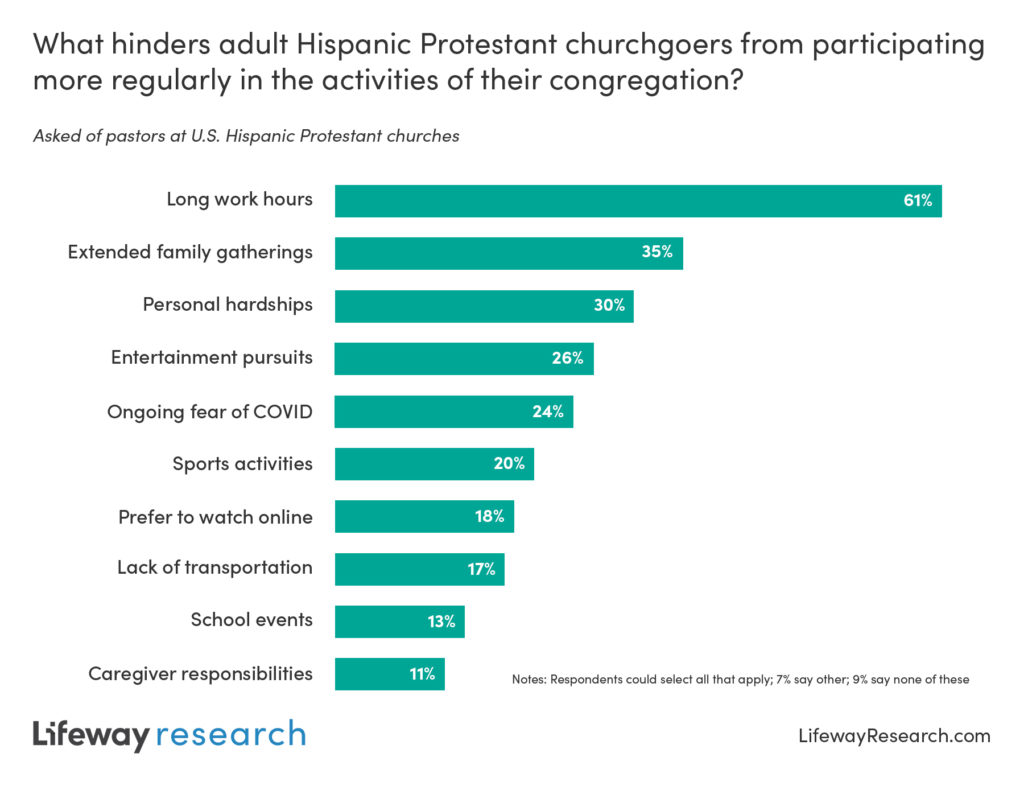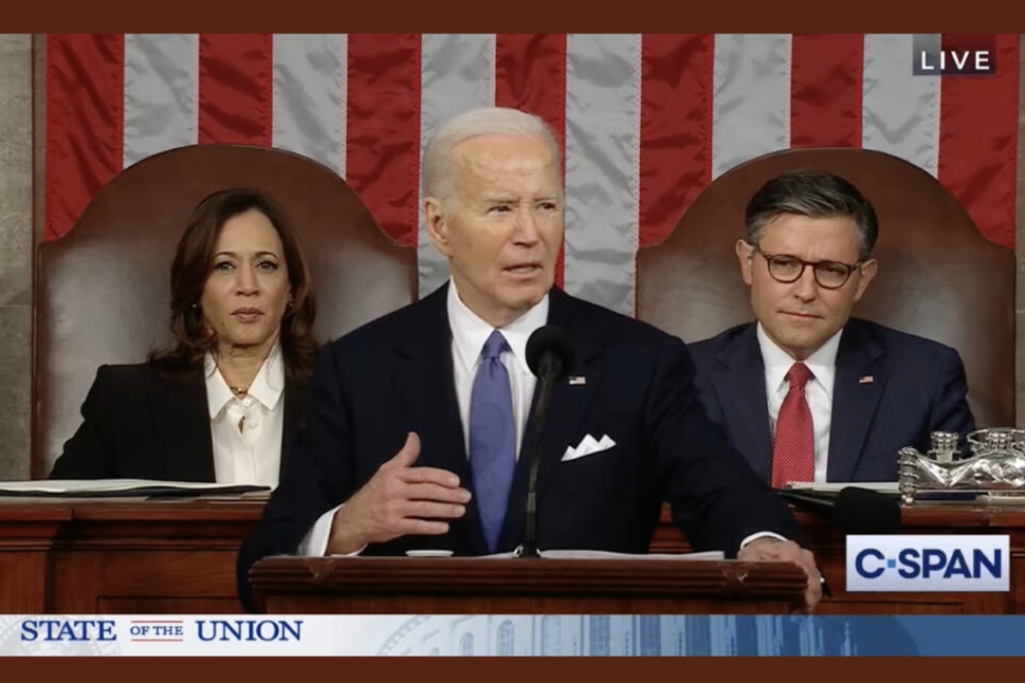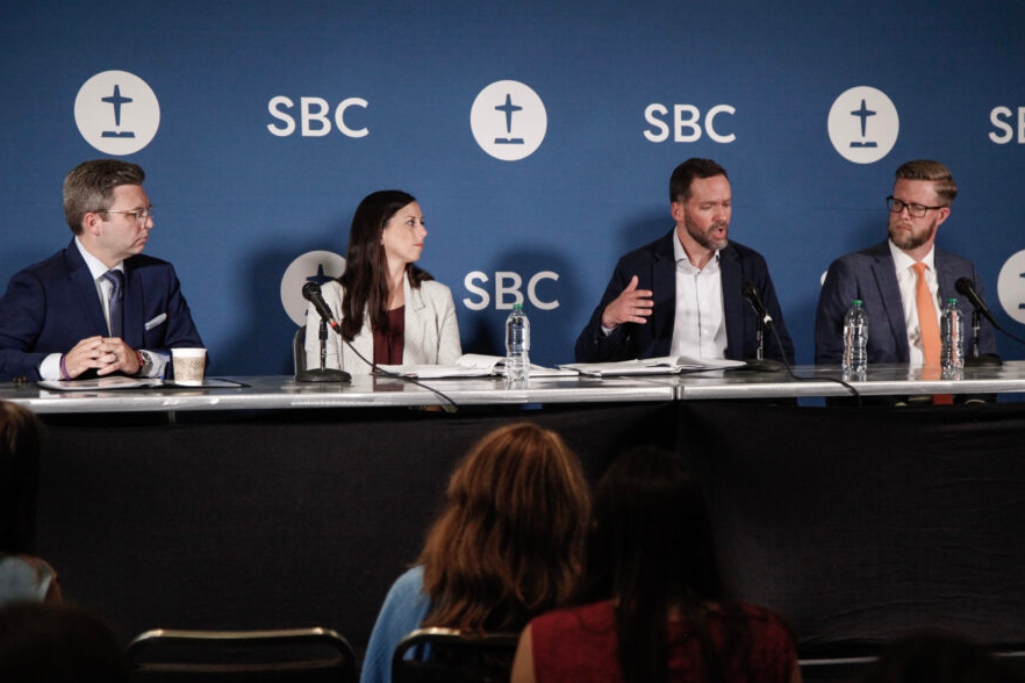
Hispanic Baptists gather for dinner and celebration prior to the 2019 SBC Annual Meeting in Birmingham, Ala.
NASHVILLE – Hispanic churches in the United States face unique challenges but are finding success in building community within their congregations and reaching those outside their walls.
Lifeway Research partnered with two dozen denominations and church networks to include what is likely the largest number of Protestant Hispanic congregations in the U.S. ever invited to a single research study. Sponsored by Lifeway Recursos, the Billy Graham Evangelistic Association and Samaritan’s Purse, the study surveyed 692 pastors of congregations that are at least 50 percent Hispanic.
“For decades, the Hispanic population in the U.S. has been growing exponentially, and it is imperative for churches to be informed about the specific needs of this community,” said Giancarlo Montemayor, director of global publishing for Lifeway Recursos. “This study will help us to continue the ongoing conversation of how to serve our brothers and sisters in a more strategic way.”
Congregational snapshot
The study reveals a picture of Hispanic churches that are newer, younger and more effectively evangelistic than the average U.S. Protestant church.
Most Hispanic Protestant churches (54 percent) have been established since 2000, including 32 percent founded in 2010 or later. Fewer than 1 in 10 (9 percent) trace their history prior to 1950.
Not only are the churches relatively new, but most people in the congregations are also new to the United States. The majority are first generation Americans (58 percent), born outside the country. A quarter are second generation (24 percent), with parents who were born outside the U.S. And 17 percent were born in the U.S. to parents who were also born in the U.S. As a result, a majority conduct their services only in Spanish (53 percent), while 22 percent are bilingual.
Half of the churches (50 percent) are in a large metropolitan area with a population of 100,000 or more. Around 3 in 10 (31 percent) are located in small cities, 9 percent are in rural areas and 8 percent are in suburbs.
In the average Hispanic Protestant church, a full third of the congregation (35 percent) is under the age of 30, including 18 percent under 18. Another 38 percent are aged 30-49, and 28 percent are 50 and older.
“The growth in the number of Hispanic churches in the U.S. has been remarkable,” said Scott McConnell, executive director of Lifeway Research. “While some of these congregations were started within Anglo churches – 14 percent of Hispanic congregations in this study currently are conducting services within a church that is predominantly non-Hispanic – the missional impetus has clearly come from within the Hispanic community itself as two-thirds of these congregations are led by first-generation immigrant pastors.”
In U.S. Hispanic Protestant churches, the average worship service attendance is 115. Like most other churches, they’ve not yet fully recovered from the pandemic. In January 2020, prior to the COVID-19 pandemic, the average attendance was 136. Still, 13 percent of churches are currently around their pre-pandemic levels. And 32 percent say they’ve grown in the past three years, despite the pandemic.

Almost every Hispanic Protestant pastor (99 percent) agrees, including 94 percent who strongly agree, their congregation considers Scripture the authority for their church and their lives.
Around 7 in 10 (69 percent) say their church has the financial resources it needs to support their ministry, which include some aspects that are common among most other Protestant congregations. Most Hispanic Protestant churches say they regularly offer weekly adult small groups or Bible studies (74 percent), weekly prayer meetings (66 percent) and weekly children’s small groups (52 percent). Fewer have weekly youth small groups (45 percent), weekly young adult small groups (40 percent), one-on-one discipleship or mentoring (34 percent), evening large group Bible study (25 percent) or evening praise and worship (24 percent). Just 3 percent say they offer none of these.
When asked about moving weekend worship service participants to small groups, 42 percent of pastors say at least half of their adult churchgoers are involved in group Bible studies, including 15 percent who say at least 75 percent are connected to a small group. Around a third (34 percent) say fewer than 1 in 4 churchgoers also are members of small group Bible studies, including 9 percent of pastors who say none of those attending worship services are involved in groups.
As to what hinders their congregation from participating more regularly in church activities, most pastors point to long work hours for their churchgoers (61 percent). Others say extended family gatherings (35 percent) and personal hardships or crises (30 percent). Around a quarter point to recreational or entertainment pursuits (26 percent) and lingering fear of COVID (24 percent). Fewer say sports activities (20 percent), a preference to watch online (18 percent), lack of transportation (17 percent), school events (13 percent) or caregiver responsibilities (11 percent).
“Many of the activities within Hispanic Protestant churches look similar to those in non-Hispanic churches in the U.S. with worship services, prayer meetings, Bible studies and Sunday School classes being common,” McConnell said. “But pastors of Hispanic congregations are quick to point out immigrant families often have less time for church as many are working long hours, have family traditions and are impacted by American cultural distractions.”
Evangelistic outreach
Almost 4 in 5 pastors at U.S. Hispanic Protestant churches (79 percent) say they regularly schedule opportunities for members to go out and share the gospel.
Specifically, most pastors say their outreach activities in the past year included church members inviting people to church (86 percent), using social media to share church activities (74 percent), children’s special events like VBS, Easter egg hunts or fall festivals (59 percent), community programs like food distribution, toy giveaways or clothing drives (58 percent), and church members sharing the gospel in conversations (56 percent). Additionally, some congregations did door-to-door evangelism (30 percent), evangelism training (24 percent) and provided financial support for a new church start (12 percent). Hardly any churches (1 percent) say they have not been able to do any of those recently.

Their outreach seems to be effective, as close to half (47 percent) say 10 or more people have indicated a new commitment to Christ in the past year, including 24 percent who have seen 20 or more such commitments. Fewer than 1 in 10 (9 percent) report no new commitments.
As they’ve reached these new individuals, pastors say most are sticking around. Almost 3 in 4 (73 percent) of those new commitments have become active participants in the life of the church, according to pastors. As a result, 88 percent of Hispanic Protestant pastors say they consistently hear reports of changed lives at their churches.
“Hispanic congregations are very active in engaging new people,” McConnell said. “Not only is there much evangelistic activity in Hispanic churches, but God is also blessing them with new people who commit to following Jesus Christ.”
Building community
As new members join Hispanic Protestant churches, they become part of congregations that are actively trying to grow together, according to their pastors. Almost 9 in 10 (88 percent) say their church has a plan to foster community in their church, including 53 percent who strongly agree.
Pastors point to numerous activities as vital to building a strong sense of community within their congregations. At least 9 in 10 say praying together (96 percent), studying the Bible together (95 percent), choosing to get along and promoting unity (93 percent), welcoming those from different cultures and backgrounds (93 percent), choosing to be transparent and accountable with one another (89 percent) and checking in or noticing when others are absent (90 percent) are very or extremely important aspects of unity in their churches. Additionally, most say the same about members working together to serve people in the community (79 percent), socializing outside of church (81 percent) and sharing resources with each other (74 percent).

Most pastors say they’ve heard about their church members engaging in each of those actions at least a few times in the past month.
“Fellowship among believers in a local congregation is something the Bible communicates should be taking place,” McConnell said. “Hispanic churches take this seriously and invest in these relationships.”
Pastoral portrait
Among pastors of U.S. Hispanic Protestant congregations, 93 percent are Hispanic themselves. Almost all (95 percent) are the senior or only pastor of a congregation, while 5 percent are Hispanic campus pastors with a multi-site church. More than half (56 percent) serve as a full-time pastor, 27 percent are bi-vocational, 10 percent are part-time, 6 percent are volunteer and 1 percent are in interim positions.
Almost half of pastors in Hispanic Protestant churches (48 percent) are between the ages of 50 and 64. Pastors are more than twice as likely to be under 50 (37 percent), including 4 percent under 30, than 65 or older (16 percent).
Almost 8 in 9 pastors (85 percent) are male. Two in 3 (66 percent) are first generation Americans, while 15 percent are second generation and 19 percent are third. Close to 3 in 4 are college graduates, including 44 percent who have a graduate degree, while 17 percent have some college and 10 percent have a high school education or less.
Theologically, 4 in 5 (79 percent) pastors at U.S. Hispanic Protestant churches self-identified as evangelical. Around 1 in 6 (16 percent) say they’re mainline.
For more information, view the complete quantitative, qualitative, and significant differences reports, and visit LifewayResearch.com.
Methodology
Sponsored by Lifeway Recursos, Billy Graham Evangelistic Association and Samaritan’s Purse, the online survey of 692 pastors of Hispanic Congregations in the U.S. was conducted Sept. 6-Nov. 1, 2022. Respondents were invited by individual denominations and networks. Invitations were primarily made by email, providing pastors with a link to the online survey. Each respondent was screened to ensure they were the senior pastor or the pastor of the Hispanic campus or Spanish-speaking congregation. Respondents were screened to ensure the congregation was a Hispanic or multiethnic church or a Spanish-speaking worship service or campus within a non-Hispanic church. Pastors of a campus or Spanish-speaking worship service were instructed to only answer for that campus/service. Only congregations that were at least 50 percent Hispanic were included.
Slight weights were used to adjust for varying response rates across denominations. The completed sample is 692 surveys. The sample provides 95 percent confidence that the sampling error does not exceed plus or minus 5.0 percent. This margin of error accounts for the effect of weighting. Margins of error are higher in sub-groups, including 11 questions intentionally asked of half of respondents to keep the survey length reasonable for each respondent.
(EDITOR’S NOTE – Aaron Earls is a writer for LifeWay Christian Resources.)


